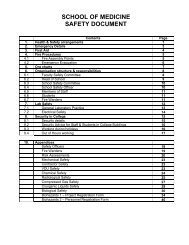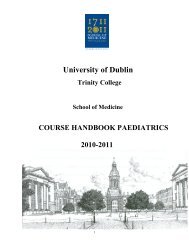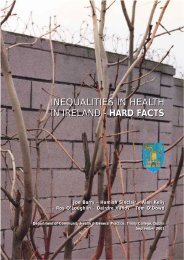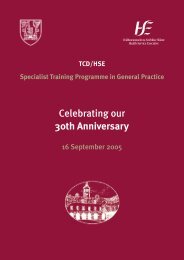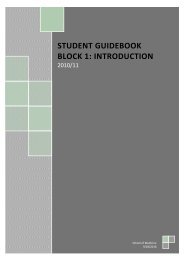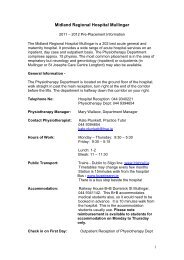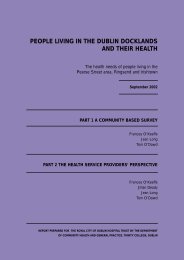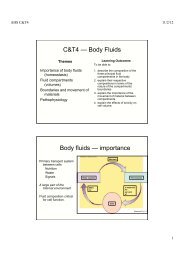people living in finglas and their health - School of Medicine - Trinity ...
people living in finglas and their health - School of Medicine - Trinity ...
people living in finglas and their health - School of Medicine - Trinity ...
Create successful ePaper yourself
Turn your PDF publications into a flip-book with our unique Google optimized e-Paper software.
SUMMARY - PART 1<br />
SUMMARY - PART 1<br />
Summary<br />
We have presented the ma<strong>in</strong> survey f<strong>in</strong>d<strong>in</strong>gs <strong>in</strong> this summary. More detailed f<strong>in</strong>d<strong>in</strong>gs are available <strong>in</strong> the results<br />
section for use by <strong>health</strong> planners employed by the area boards. The <strong>in</strong>formation conta<strong>in</strong>ed <strong>in</strong> this document is<br />
also pert<strong>in</strong>ent to those work<strong>in</strong>g <strong>in</strong> primary care or with a special <strong>in</strong>terest <strong>in</strong> <strong>health</strong> care.<br />
What we set out to do<br />
We set out to assess the <strong>health</strong> needs <strong>of</strong> households <strong>and</strong> <strong>their</strong> <strong>in</strong>dividual members resid<strong>in</strong>g <strong>in</strong> F<strong>in</strong>glas.<br />
How we conducted the assessment<br />
Initially, we contacted key <strong>in</strong>dividuals <strong>in</strong> the community to <strong>in</strong>form them <strong>of</strong> the proposed study <strong>and</strong> to ascerta<strong>in</strong><br />
the key <strong>health</strong> <strong>and</strong> social issues <strong>in</strong> the area. We <strong>in</strong>cluded these issues <strong>in</strong> the questionnaire. We then conducted<br />
a cross sectional study <strong>in</strong> the twelve district electoral divisions <strong>of</strong> the study area. We <strong>in</strong>terviewed primary or<br />
pr<strong>in</strong>cipal carers (def<strong>in</strong>ed as the person <strong>in</strong> the household who manages the welfare <strong>and</strong> <strong>health</strong> <strong>of</strong> the<br />
family/household) <strong>in</strong> 325 <strong>of</strong> the selected 420 households. We selected the households employ<strong>in</strong>g a cluster<br />
sampl<strong>in</strong>g methodology. We chose 30 clusters from both the four less deprived district electoral divisions <strong>and</strong><br />
the eight more deprived district electoral divisions. Each <strong>of</strong> the 60 clusters consisted <strong>of</strong> seven adjacent<br />
households. We <strong>in</strong>terviewed the primary carers <strong>in</strong> <strong>their</strong> homes, us<strong>in</strong>g an <strong>in</strong>terviewer adm<strong>in</strong>istered questionnaire.<br />
What we found <strong>in</strong> the survey<br />
Of the 420 households selected to participate <strong>in</strong> the survey, over 77% participated, <strong>in</strong>dicat<strong>in</strong>g a keen <strong>in</strong>terest<br />
<strong>in</strong> <strong>health</strong> related issues. Data were also collected on 963 <strong>in</strong>dividuals resid<strong>in</strong>g <strong>in</strong> these houses.<br />
The <strong>people</strong> <strong>of</strong> the area<br />
This is generally an older population with one third over the age <strong>of</strong> 50 years <strong>and</strong> almost half <strong>of</strong> these aged 65<br />
years or over. Eighty-three <strong>of</strong> the primary carers were aged between 65 <strong>and</strong> 85 years old, <strong>of</strong> whom, 30 (36%)<br />
were <strong>liv<strong>in</strong>g</strong> on <strong>their</strong> own. Of those who stated that they were the primary carers, one third were men.<br />
Primary or pr<strong>in</strong>cipal carers reported that:<br />
• 44% <strong>of</strong> all household members were outright owners <strong>of</strong> <strong>their</strong> homes, 12% <strong>of</strong> householders<br />
were resid<strong>in</strong>g <strong>in</strong> government supported accommodation,<br />
• 31% <strong>of</strong> households did not own a car,<br />
• just 2% <strong>of</strong> households were occupied by non-nationals,<br />
• 35% <strong>of</strong> households had medical card cover,<br />
• 26% <strong>of</strong> households had neither medical card nor private <strong>health</strong> <strong>in</strong>surance,<br />
• 13% described themselves as lone parents,<br />
• 40% <strong>of</strong> primary carers had primary school education or less.<br />
Lifestyle <strong>and</strong> family issues<br />
Primary or pr<strong>in</strong>cipal carers reported that:<br />
• 63% had experienced stress <strong>in</strong> the year prior to the survey,<br />
<strong>of</strong> these,<br />
• 41% consulted <strong>their</strong> general practitioner because <strong>of</strong> <strong>their</strong> stress,<br />
• 25% had received prescribed medication,<br />
• 8% had visited a counsellor.<br />
• 12% experienced violence or <strong>in</strong>timidation <strong>in</strong> the previous year,<br />
<strong>of</strong> these,<br />
• 26% had experienced the <strong>in</strong>cident <strong>in</strong> <strong>their</strong> own homes,<br />
• 55% had reported the violent <strong>in</strong>cident to the police,<br />
• 37% had sought medical assistance.<br />
• 54% worried about <strong>their</strong> teenagers’ socialis<strong>in</strong>g,<br />
• 46% found <strong>their</strong> teenagers’ attitudes or behaviours upsett<strong>in</strong>g,<br />
• 28% <strong>of</strong> household members, 18 years or over, smoked,<br />
• 1% <strong>of</strong> household <strong>in</strong>dividuals, aged 18 years <strong>and</strong> older, had a problem with either alcohol or drugs.<br />
Chronic illness <strong>and</strong> disability<br />
Primary carers reported that:<br />
• 29% (adjusted) <strong>of</strong> the 963 household members had a chronic illness,<br />
• the most common chronic illnesses were cardiovascular disease (33%), respiratory (25%) <strong>and</strong> arthritis (12%).<br />
• Overall, 4% (adjusted) <strong>of</strong> household members had a disability (either mental or physical),<br />
<strong>of</strong> these,<br />
• 30% had <strong>their</strong> disability s<strong>in</strong>ce birth,<br />
• 80% reported a physical disability.<br />
Hospital services<br />
Primary or pr<strong>in</strong>cipal carers reported that:<br />
• 33% (adjusted) <strong>of</strong> household members used a hospital service <strong>in</strong> the 12 months prior to the survey, <strong>of</strong> these;<br />
• the ma<strong>in</strong> reasons for attend<strong>in</strong>g were <strong>in</strong>jury or an acute emergency (19%), cardiovascular disease<br />
(15%), <strong>and</strong> ear, nose, throat <strong>and</strong> eye problems (11%),<br />
<strong>of</strong> those who used hospital services:<br />
• 62% were elective or planned attendances at the hospital,<br />
• 43% attended outpatients, 24% were seen <strong>in</strong> accident <strong>and</strong> emergency, 11% were day patients <strong>and</strong><br />
• 23% were admitted to hospital,<br />
• 79% were satisfied with outpatient services,<br />
• 72% were satisfied with <strong>in</strong>patient services,<br />
• 92% were satisfied with the day care service,<br />
• 66% were satisfied with the accident <strong>and</strong> emergency service.<br />
• The ma<strong>in</strong> reasons for satisfaction <strong>and</strong> dissatisfaction were common to all hospital services,<br />
• the ma<strong>in</strong> reasons for satisfaction were that staff were friendly <strong>and</strong> the <strong>in</strong>dividuals had<br />
received good treatment <strong>and</strong> care,<br />
• the ma<strong>in</strong> reason for dissatisfaction was the long wait<strong>in</strong>g periods encountered.<br />
• Hospital services were more likely to be used by those with chronic illness, those attend<strong>in</strong>g the general<br />
practitioner <strong>and</strong> those wait<strong>in</strong>g for <strong>health</strong> care.<br />
Health services for women<br />
Female primary or pr<strong>in</strong>cipal carers (<strong>of</strong> child bear<strong>in</strong>g age) reported that:<br />
• 50% (56/113) were us<strong>in</strong>g a method <strong>of</strong> family plann<strong>in</strong>g,<br />
• 52% <strong>of</strong> women aged 18 to 65 had a smear <strong>in</strong> the last five years,<br />
• 50% <strong>of</strong> women aged 18 to 65 had a breast exam<strong>in</strong>ation <strong>in</strong> the last five years,<br />
• 41% <strong>of</strong> women aged 52 to 66 years (eligible for the BreastCheck programme) had a mammogram <strong>in</strong> the<br />
last five years.<br />
Primary or pr<strong>in</strong>cipal carers reported that:<br />
• 52% <strong>of</strong> the women’s most recent pregnancies were planned,<br />
• 38% opted for general practitioner <strong>and</strong> hospital shared care,<br />
• 24% <strong>of</strong> the women smoked dur<strong>in</strong>g <strong>their</strong> last pregnancy,<br />
• 85% delivered <strong>their</strong> last child <strong>in</strong> the Rotunda Hospital.<br />
10<br />
11






